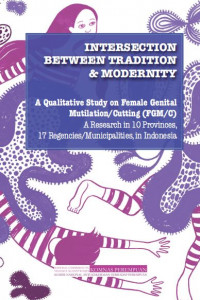
Text
Intersection Between Tradition and Modernity : A Qualitative Study on Female Genital Mutilation/Cutting (FGM/C) A Research in 10 Provinces, 17 Regencies/Municipalities, in Indonesia
The practice of FGM/C can be traced back to as far as 6,000 years ago (Milos & Macris, 1992). A group of Dutch researchers found that FGM/C was practiced in Aceh, Java, and Gorontalo by the Sundanese, the Bugis, and the Minangkabau in the 18th century (Putranti, 2009). However, Indonesian government had revised the policies related to FGM/C practices several times. In 2006, the Ministry of Health issued a circular of Director General of Public Health Education number HK.00.07.1.3.1047a, which prohibits health workers from medicalizing FGM/C. Enraged by the act, the Indonesian Ulema Council (MUI) issued a religious decree (fatwa) in 2008, stating that FGM/C is “makrumah” (honorable) and prohibiting FGM/C is against Islam. The fatwa puts MUI at odds with Muhammadiyah —another big Islamic organization—who condemns FGM/C (Komnas Perempuan, 2014). The disagreement eventually pushed the Ministry of Health to issue Regulation on Female Genital Mutilation/Cutting Number 1636 on 15 November 2010. Instead of condemning FGM/C, the regulation endorses the practice in the name of the girls’ own safety and details a procedure to guide health workers in carrying out the mutilation/cutting (Komnas Perempuan, 2014). This research may help formulate a set of recommendations about FGM/C for the central and the regional governments. Through this research we strongly expect the Government to ful!ill the rights of women, speci!ically their reproductive and sexual rights, by prohibiting FGM/C, which is part of violence against women.
Availability
| KP IX.000122 | KP IX KHA i | Perpustakaan Komnas Perempuan (Perpustakaan Komnas Perempuan) | Available |
Detail Information
- Series Title
-
-
- Call Number
-
KP IX KHA i
- Publisher
- Jakarta : [Komnas Perempuan]., 2018
- Collation
-
143 hlm; 17 cm
- Language
-
Indonesia
- ISBN/ISSN
-
978-602-330-030-3
- Classification
-
KP IX
- Content Type
-
-
- Media Type
-
-
- Carrier Type
-
-
- Edition
-
-
- Subject(s)
- Specific Detail Info
-
-
- Statement of Responsibility
-
-
Other version/related
No other version available
File Attachment
Comments
You must be logged in to post a comment
 Computer Science, Information & General Works
Computer Science, Information & General Works  Philosophy & Psychology
Philosophy & Psychology  Religion
Religion  Social Sciences
Social Sciences  Language
Language  Pure Science
Pure Science  Applied Sciences
Applied Sciences  Art & Recreation
Art & Recreation  Literature
Literature  History & Geography
History & Geography